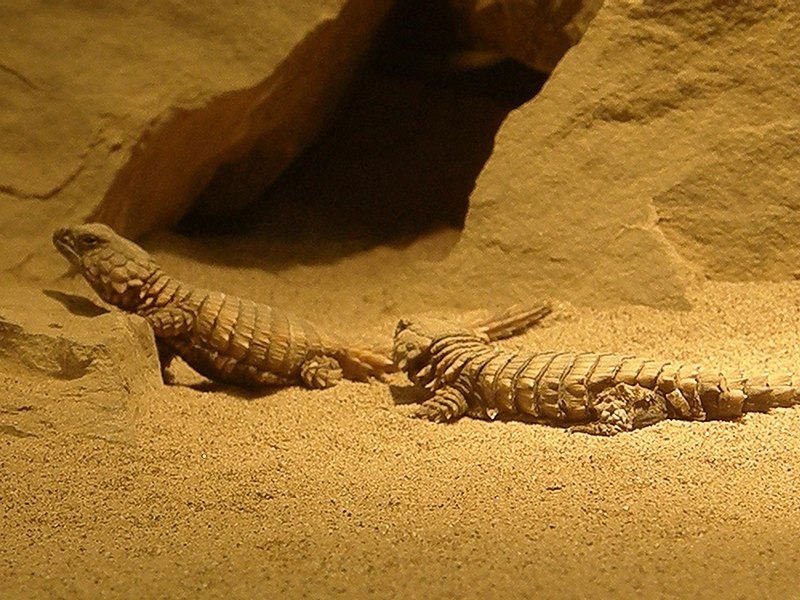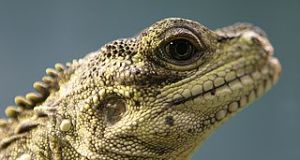In Part I of this article we discussed the care of the Tropical Girdled Lizard (Cordylus tropidosternum), one of the most commonly available of the 37 interesting species in the genus Cordylus (among the Girdled Lizard’s relatives is the much sought-after Armadillo Lizard, C. cataphractus, see photo). Also known as the East African Spiny-tailed Lizard, its unique appearance and behaviors are quite captivating. Today we’ll cover captive reproduction in more detail.
Temperature Fluctuations in Nature and Captivity
 In their native South Africa, Tropical Girdled Lizards hibernate during the winter, and a cooling off period was believed necessary to induce captive reproduction. Good results are usually achieved after captives have been held at temperatures of 58-60 F for 4-6 weeks. During this time they move about a bit, and drink, but do not feed.
In their native South Africa, Tropical Girdled Lizards hibernate during the winter, and a cooling off period was believed necessary to induce captive reproduction. Good results are usually achieved after captives have been held at temperatures of 58-60 F for 4-6 weeks. During this time they move about a bit, and drink, but do not feed.
However, I’ve recently received reports of captive births (females bear 1-4 large, well-developed youngsters) among lizards subjected to little if any change in temperature. In some situations, normal seasonal fluctuations in the temperature of the room in which the lizards are held seems to be enough to stimulate reproduction.
Reproduction Without a Traditional “Winter”
In the most recent breeding of which I’ve been informed, births occurred in a terrarium maintained at an ambient of 77 F with a basking site of 95 F. The room in which the terrarium was located was heated during the winter and air conditioned during the summer, which may have “switched seasons” on the lizards, but they bred none-the-less.
In another situation, the terrarium was in a room maintained at approximately 75 F year-round, but, being near a window, may have been subjected to the effects of outdoor temperatures.
Caring for Youngsters – UVB Light
Tropical Girdled Lizards seem to form loosely connected colonies in the wild; captives usually fare well in groups, but dominant individuals sometimes prevent others from feeding and basking.
Young lizards should have access to UVB light. However, they are quite shy, and may not bask often, especially if adults are present. Also, they tend not to climb to the top of rock piles and such when basking, preferring to remain at or close to the terrarium’s floor – at which point they may be too far from the bulb to obtain adequate UVB exposure. Therefore, newborns are best removed to shallow enclosures, in order to maximize UVB exposure (they should be able to bask within 6-12 inches of florescent UVB bulbs).
Useful UVB and UVA Lamps (Bulbs)
A Zoo Med 10.0 UVB bulb positioned within 6 to 8 inches of the basking site, is ideal. Mercury vapor bulbs can be used in situations where the basking site cannot be positioned within 12 inches of the bulb.
A source of UVA light, while perhaps not critical for survival, will help to encourage natural behaviors and reproduction.
Further Reading
Recently I have helped to set up new reptile and amphibian exhibit areas for The Maritime Aquarium in Norwalk, CT (long known for its excellent collection of native marine life), and was happy to learn that Girdled Lizards have reproduced there (off exhibit).
A listing of all 37 Cordylus species, along with range and other information, is posted here.
While the role of UVB light in reptile care is well-understood, we know less about UVA. For some thoughts and observations, please see Providing UVA to Reptiles and Amphibians.
Armadillo Girdle tailed Lizard image referenced from wikipedia and originally posted by Ltshears from flickr and Frank Wouters
 That Reptile Blog – Reptile, Amphibian and Exotic Pet Care and Information
That Reptile Blog – Reptile, Amphibian and Exotic Pet Care and Information



My pair just successfully bred. While no direct effort was made to bring their environment as low as 58 degrees, they were given a good 10-15 degree drop in average temperature in their tank, aside from their basking area. It may be a function of my pair being somewhat young, but my babies are quite a bit smaller than the one pictured here, although they are all thriving.
Hello Rob, Frank Indiviglio here.
Thanks so much for writing in with your observations – very useful to see the different strategies to work, I’m interested to see if the details change over time as later generations possibly adapt to captivity. Useful for related endangered species as well.
If you have a moment and can forward temperature parameters/ length of time temp was lowered, I would be most grateful.
Good luck raising the young and please keep me posted.
Best regards, Frank Indiviglio.
Hello Frank,
I have a few concerns about my UVB lighting for some Cordylus tropidosternum that I hope to buy soon. I accidentally ended up with two Arcadia* T-5 12% Desert UVB fluorescent tubes. I continue to see the use of only zoomed or eco terra 10.0 or sometimes 12.0 UVBs. If I plan to care for my Cords in a 20 gallon tall, with a 15 in. height, do you think they will thrive with that sort of output from my Arcadia* lights? Thank you for all the great work you do on your blog, I love seeing all the articles. This article in particular is very useful to me, and I can always trust your opinion if in need.
Thank you,
Samuel
Hello Smauel,
Thanks for the kind words, much appreciated. I’m not familiar with Arcadia bulbs; but the company is well-known. They should have specs available on their website or if you write to customer service. The actual output will likely be similar to that of other bulbs, as the technology seems to be well-known. Check into info re effective range, as that is where problems can arise. In older florescent bulbs, output falls off sharply after 6-12 inches. If that is the case with the bulbs you have, you’d need to build up the basking site so that the lizards can get that close. Cordylus are sometimes reluctant to climb a rock pile or driftwood…they seem ill at ease in such situations. Likely they bask in more protected sites in wild. If that is the case, you’d be better off with a bulb having an effective range of 20″ or so. Pleases let me know if you need anything, best, frank
hi frank!
Recently (yesterday) i acquired a breeding pair of the forest armadillo lizards. while i have wanted one for a while, was not expecting 2 let alone a sexed pair. I am prepared to care for them and have done my research on feeding, substrate and the like, my question is when mommy gives birth are the young viable at birth? can i move them from the parents enclosure? have gotten mixed answers on this and would like clarification. thanks for the above information! i am excited to have these new animals in m home.
Hi Kendall,
Best to move them (they are able to move, feed right away), as adults can inhibit feeding/basking, out-compete, etc. Also, young may not bask in open as do adults. Please see notes in article re exhibit depth, UVB, and let me know if you have any questions…good luck, Frank
ok well i read the other comments while searching around and i think i got my answers. thanks forbeing knowledgeable about these guys!
ok so i have been scouring the internet and this site to see what types of other foods to feed. i have bearded dragons that eat well on collards turnip and mustard greens and im wondering if these would be appropriate to feed my lizards or if there are other veggies to feed them. truly id like a list or a link to a list. Thanks!
Hello,
Girdled lizards are entirely insectivorous; some individuals may accept a bit of fruit on occasion, but greens etc are not taken. Please see this article on feeding insectivorous lizards and let me know if you need further info. best, Frank
Can 2 male girdled lizards(forest) live with 3 female girdled lizards?
Hello Gail,
Males usually fight, although 2 may sometimes work out in a very large, well-designed enclosure. But especially with females present, it’s very risky. Best, Frank
Hi there my name is nancy and to let you all know my past lizard I had died. So I went out and got me a mountain horned lizard I did and I am a little worried about him I am and the reason I am is because I feel I really set his tank up nicely with a UVB of 100 and also a led red light for the heat equivalent to a 150 watt bulb they say. Plus I got hummity in there a reticle foggier as well and a water dish with air bubbles in it too and his worm dish too I think he did eat a few worms I offered it cause not in dish no more. Since I got him all I ever see him do is sit around either on his long stick or rocks and cave type thing with his eyes shutt all the time is that normal for them to do that or not makes me worried on that it does. He only wakes up if I touch him or try to hold him then goes back to shutting his eyes is under stress or not? I got temperatures gauges in his 18×18 cage plus hummity gage too hope to keep that at 60 or 70 percent. So my main question is am I doing ok to keep this little guy at his best or not please any advice would be helpful thanks nancy
Hello Nancy,
Most of the Mt Horned Lizards offered for sale have been wild caught…they usually are suffering from various parasites, dehydrated and are stressed from shipment. A visit to an experienced reptile vet is the best option/…please let me know if you need help in locating one.
They are not very active, but staying with eyes closed is not a good sign…you shouldn’t handle the animal at this point, as this will add to its stress level even if you see no outward signs.
Temperature of 78 with a basking site of 82-85 is ideal…large cages important so that areas of different temperature can be established.
Are you referring to mealworms? These are not an appropriate diet, and should be avoided. the diet must be highly varied…earthworms and crickets can form the basis of the diet, but roaches, silkwoms, butterworms, calci worms and sowbugs should also be offered (available online). Be sure to feed crickets well before use, and powder most meals with Ca. Please see this article for more on feeding insectivorous lizards
However, your first step should be a vet visit to check for parasites and other health problems, best, Frank
Please notify me once you know on this thanks nancy